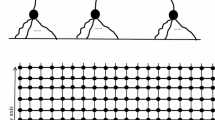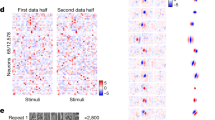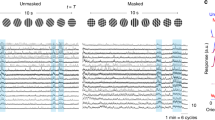Abstract
Visual cortical simple cells have been experimentally shown to reveal non-trivial spatio-temporal orientation tuning functions comprising different phases of specifically tuned enhanced and suppressed activity. A recently developed analytical method based on nonlinear neural field models suggests that such space-time responses should be approximately separable into a sum of temporally amplitude modulated Gaussian spatial components. In the present work, we investigate this possibility by means of numerical fits of sums of Gaussians to response functions observed in experiments and computer simulations. Because the theory relates each single component to a particular connectivity kernel between the underlying cell classes shaping the response, the relative contribution of feedforward and cortex-intrinsical excitatory and inhibitory feedback mechanisms to single cell tuning can be approached and quantified in experimental data.
Similar content being viewed by others
References
Adorján P, Levitt J, Lund J, Obermayer K (1999) A model for the intracortical origin of orientation preference and tuning in Macaque striate cortex'. Visual Neurosci. 16: 303-318.
Ben-Yishai R, Bar-Or RL, Sompolinsky H (1995) Theory of orientation tuning in visual cortex. Proc. Natl. Acad. Sci. USA 92: 3844-3848.
Carandini M, Ringach DL (1997) Predictions of a recurrent model of orientation selectivity. Vision Res. 37: 3061-3071.
Ermentrout GB, Cowan JD (1979) Mathematical theory of visual hallucination patterns. Biol. Cybern. 34: 137-150.
Ferster D, Koch C (1987) Neuronal connections underlying orientation selectivity in cat visual cortex. Trends Neurosci. 10: 487-492.
Ferster D, Miller KD (2000) Neural mechanisms of orientation selectivity in the visual cortex. Annu. Rev. Neurosci. 23: 441-471.
Gillespie C, Lampl I, Anderson JS, Ferster D (2001) Dynamics of the orientation-tuned membrane potential response in cat primary visual cortex. Nature Neurosci. 4: 1014-1019.
Heeger D (1992) Half-squaring in responses of cat simple cells. Vis. Neurosci. 9: 427-443.
Hubel DH, Wiesel TN (1962) Receptive fields, binocular interaction and functional architecture in the cats visual cortex. J. Physiol. Lond. 160: 106-154.
Miller KD, Troyer TW (2002) Neural noise can explain expansive power-law nonlinearities in neural response functions. J. Neurophysiol. 87: 653-659.
Press WH, Teukolsky SA, Vetterling WT, Flannery BP (1993) Numerical Recipes in C: The Art of Scientific Computing. Cambridge University Press, Cambridge, MA.
Pugh MC, Ringach DL, Shapley R, Shelley MJ (2000) Computational modeling of orientation tuning dynamics in monkey primary visual cortex. J. Comput. Neurosci. 8: 143-159.
Reid RC, Alonso JM (1996) The processing and encoding of information in the visual cortex. Current Opinion in Neurobiology 6: 465-480.
Ringach DL, Hawken ML, Shapley R (1997) The dynamics of orientation tuning in macaque V1. Nature 387: 281-284.
Samsonovic A, McNaughton BL (1997) Path integration and cognitive mapping in a continuous attractor neural network model. J. Neurosci. 17: 5900-5920.
Somers DC, Nelson SB, Sur M (1995) An emergent model of orientation selectivity in cat visual cortex simple cells. J. Neurosci. 15: 5448-5465.
Sompolinsky H, Shapley R (1997) New perspectives on the mechanism for orientation selectivity. Curr. Opin. Neurobiol. 7: 514-522.
Suder K, Wörgötter F, Wennekers T (2001) Neural field model of receptive field restructuring in primary visual cortex. Neural Comp. 13: 139-159.
Suder K, Funke K, Zhao Y, Kerscher N, Wennekers T, Wörgötter F (2002) Spatial dynamics of receptive fields in cat primary visual cortex related to the temporal structure of thalamo-cortical feed-forward activity-Experiments and models. Exp. Brain Res. 144: 430-444.
Troyer TW, Krukowski AE, Priebe NJ, Miller KD (1998) Contrast-invariant orientation tuning in cat visual cortex: Thalamocortical input tuning and correlation-based intracortical connectivity. J. Neurosci. 18: 5908-5927.
Wennekers T (2001) Orientation tuning properties of simple cells in area V1 derived from an approximate analysis of nonlinear neural field models. Neural Comp. 13: 1721-1747.
Wennekers T (2002) Dynamic approximation of spatio-temporal receptive fields in nonlinear neural field models. Neural Comp. 14: 1801-1825.
Wilson HR, Cowan JD (1973) A mathematical theory of the functional dynamics of cortical and thalamic nervous tissue. Kybernetik 13: 55-80.
Wörgötter F, Suder K, Zhao Y, Kerscher N, Eysel UT, Funke K (1998) State-dependent receptive-field restructuring in the visual cortex. Nature 396: 165-167.
Zhang K-C (1996) Representation of spatial orientation by the intrinsic dynamics of the head-direction cell ensemble: A theory. J. Neurosci. 16: 2112-2126.
Author information
Authors and Affiliations
Rights and permissions
About this article
Cite this article
Wennekers, T. Separation of Spatio-Temporal Receptive Fields into Sums of Gaussian Components. J Comput Neurosci 16, 27–38 (2004). https://doi.org/10.1023/B:JCNS.0000004839.49178.2d
Issue Date:
DOI: https://doi.org/10.1023/B:JCNS.0000004839.49178.2d




